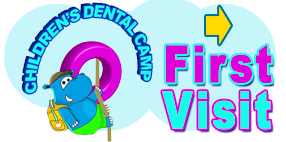Usually at about six months, but there is a huge variation between different babies. Some start erupting their teeth soon after they are born which makes them very prone to cavity, and some are toothless until they are 18 months old. The order in which the teeth erupt is almost always the same. The lower anterior teeth usually come in first.
As soon as they erupt through the gums. You may use a gauze square or a little terrycloth finger cover or baby size soft bristle toothbrush. Place the brush squarely against the tooth at the gumline and brush side to side and massage the gum. You may use an infant toothpaste or just wet toothbrush. At age three years old, you may place a pea size kid’s toothpaste on the toothbrush and ask your child to spit. If they swallow a small portion of the toothpaste , it is Ok. Keep toothpaste out of the reach of young children; some children eat Is toothpaste as a treat.
The American Academy of Pediatrics recommends that one year of age is a good time to have a first exam. This lets the parent and dentist get an early start on a prevention program that will keep decay away and minimize other dental problems too. If you see any suspicious spots on your baby's teeth, particularly if the teeth came in early or the baby has been taking a bottle to bed, don't wait. Bring the baby any time you suspect a problem.
The dental home is the ongoing relationship between the dentist and the patient, inclusive of all aspects of oral health care delivered in a comprehensive, continuously accessible, coordinated, and family-centered way.
Definition of Dental Home – AAPD
Dental caries is a disease of the teeth caused by bacteria, suger and tooth. Certain types of bacteria will produce acid if the bacteria is feeding on sugars or fermentable carbohydrates. This acid will break down the mineral structure of the teeth, and the result is a cavity. ECC is defined as the presence of a cavity in a tooth in a child under six years of age. The most common cause of ECC is by taking a bottle with anything liquid such as Milk, formula, and juice before napping or sleeping( water is fine). When the baby is sleeping, its saliva is not washing across the teeth to protect them from decay acid. Nearly 100% of tooth decay in infants and toddlers is caused by the nighttime bottle, and ECC is the largest cause of dental procedures for children between 12 and 36 months.
You need to wean your child from the bottle, nursing, or drinking from Sippy cup before bedtime. If you are not able to successfully wean your child you should replace the milk or juice with plain water. When the child is sleeping, the saliva does not wash over the teeth to give protection from decay acid. Brush your toddler's teeth twice a day in a thorough way and avoid candies, juice, and sticky fruits such as raisin as a snack. See your pediatric dentist for their first exam by the age of one.
Many toddlers resist. You may introduce the toothbrush as a toy at first. Allow the toddler/ or infant to brush independently with your supervision while you brush your own teeth. Then after you should go over their brushing as a game. If all fails place the toddler's head in your lap, and brush their teeth. This may be a two parent activity for a while, but don't give up.
Six month checkups are best for most children. Some children with good oral hygiene and no dental cavities may be seen annually.
Sealant is a protective covering made of composite (plastic filling) which protect and seal the top surface of the tooth where there have pits and grooves. It is highly recommended for the permanent molars usually around six years of age. It will not protect the other surfaces of the tooth, therefore brushing and flossing are still necessary to prevent dental decay. We also recommend this procedure for primary molar, if your child is cooperative or need other dental treatment.


